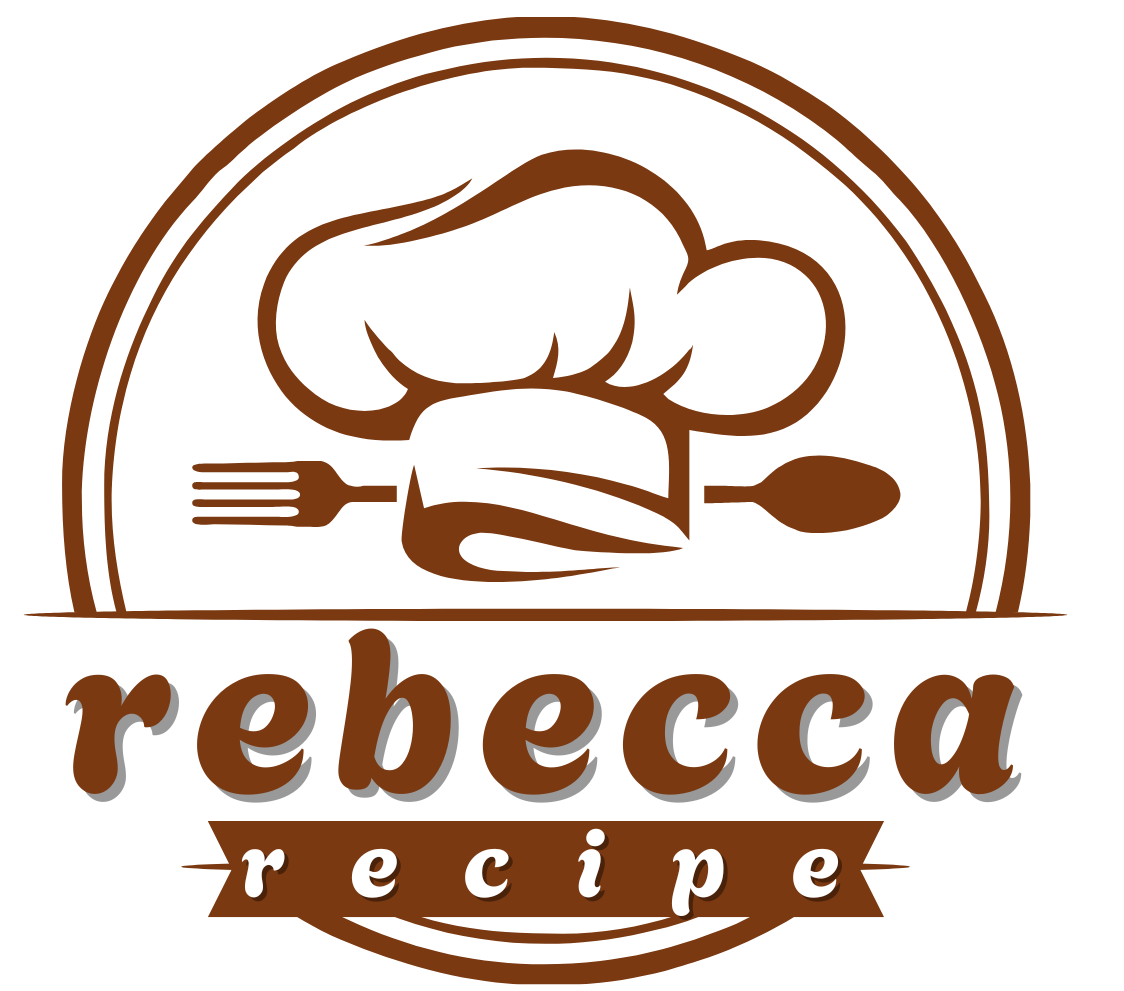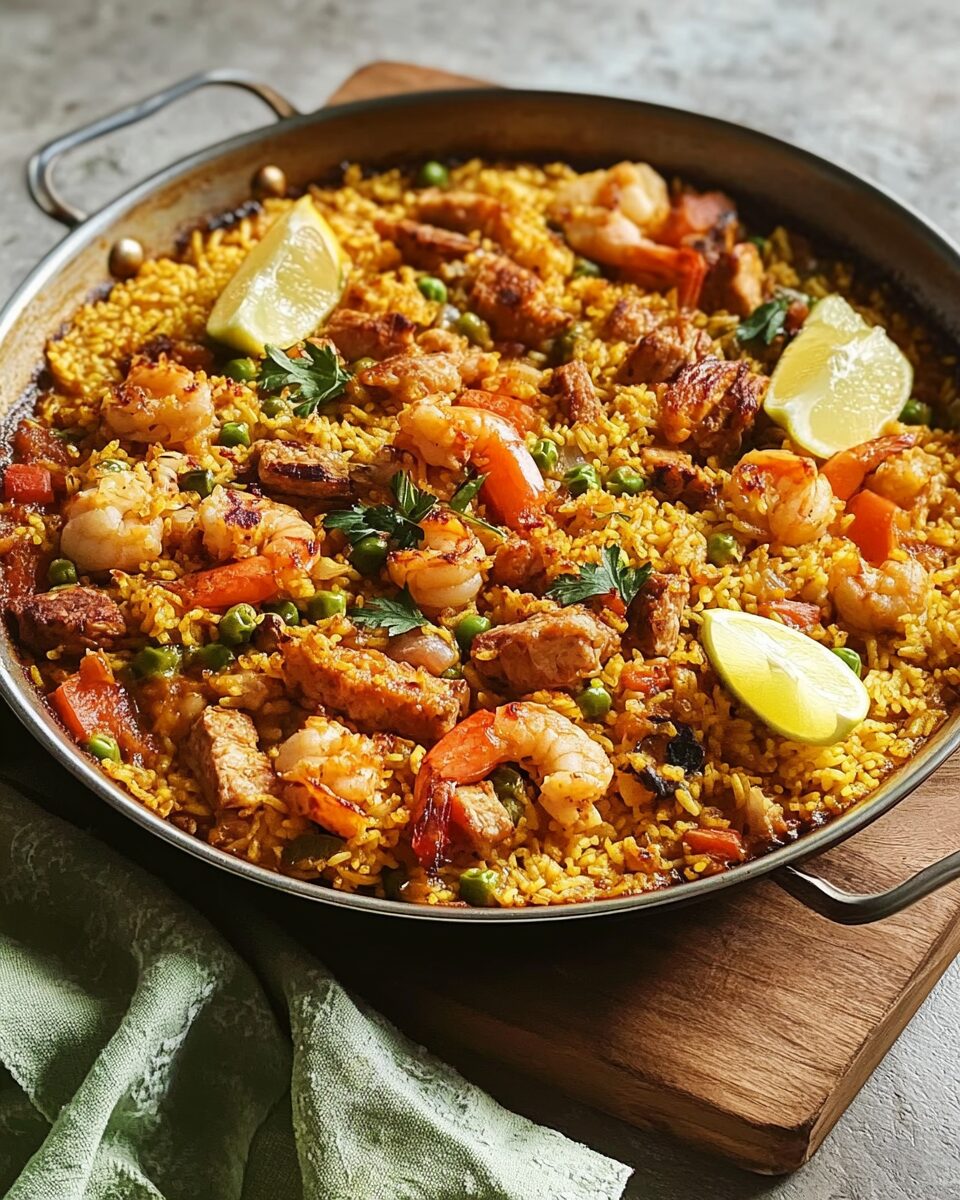Easy Paella is a vibrant and flavorful Spanish dish that brings together rice, seafood, chicken, and aromatic spices. Traditionally cooked in a wide, shallow pan, paella is known for its rich saffron-infused rice and crispy bottom layer called “socarrat.” This simplified version makes it easy to recreate the classic Spanish dish at home without requiring specialized equipment or hard-to-find ingredients.
Full Recipe:
Ingredients
- 2 tablespoons olive oil
- 1 onion, chopped
- 2 cloves garlic, minced
- 1 red bell pepper, sliced
- 1 cup uncooked Arborio or long-grain rice
- 2 cups chicken broth
- 1/2 teaspoon saffron threads
- 1 teaspoon smoked paprika
- 1/2 teaspoon salt
- 1/4 teaspoon black pepper
- 1/2 pound boneless, skinless chicken breast, diced
- 1/2 pound shrimp, peeled and deveined
- 1/2 cup frozen peas
- 1/2 cup diced tomatoes
- 1/4 cup chopped fresh parsley
- Lemon wedges for garnish
Directions
- Heat olive oil in a large skillet over medium heat. Sauté onion, garlic, and bell pepper until softened.
- Stir in rice, coating it with the oil and vegetables for about 2 minutes.
- Pour in chicken broth, saffron, smoked paprika, salt, and pepper. Stir well and bring to a gentle simmer.
- Add diced chicken and cook for 10 minutes, stirring occasionally.
- Place shrimp on top of the rice mixture and add peas and tomatoes. Cover and cook for another 5-7 minutes until shrimp is pink and rice is tender.
- Remove from heat, sprinkle with fresh parsley, and serve with lemon wedges.
Nutrients
- Calories: 400 per serving
- Carbohydrates: 45g
- Protein: 28g
- Fat: 12g
- Saturated Fat: 2g
- Cholesterol: 120mg
- Sodium: 600mg
- Fiber: 3g
- Sugar: 4g
The Origins of Paella
Paella originated in the Valencia region of Spain, where it was initially a farmer’s dish made with locally available ingredients such as rice, vegetables, rabbit, and snails. Over time, the dish evolved, and different regions of Spain developed their own variations, incorporating seafood, chicken, and other meats. Today, paella is one of Spain’s most internationally recognized dishes, enjoyed by people around the world.
The name “paella” actually refers to the pan used to cook the dish rather than the meal itself. Traditionally, paella is cooked over an open flame, allowing the bottom layer of rice to develop a crispy, golden crust known as “socarrat.” This layer is highly prized in authentic paella preparation, as it adds a rich and slightly toasted flavor to the dish.
Why Paella is a Popular Dish
Paella is more than just a meal; it’s a cultural experience. In Spain, paella is often prepared for special gatherings, family celebrations, and outdoor cookouts. The dish is designed to be shared, making it a symbol of togetherness and hospitality.
Some of the reasons why paella remains a favorite among food lovers include:
- Versatility – Paella can be adapted to different tastes by adding seafood, chicken, vegetables, or even vegetarian alternatives.
- Rich and Aromatic Flavors – The combination of saffron, smoked paprika, and fresh ingredients creates a depth of flavor that is both comforting and satisfying.
- A One-Pan Meal – Everything is cooked in a single pan, making preparation and cleanup easier compared to multi-course meals.
- Great for Entertaining – Whether served at a dinner party or a casual family meal, paella is a visually stunning and impressive dish that guests love.
Different Types of Paella
There are several traditional variations of paella, each offering a unique combination of ingredients and flavors. Some of the most popular types include:
- Paella Valenciana – The original version from Valencia, made with rabbit, chicken, green beans, and sometimes snails. This is considered the most traditional form of paella.
- Seafood Paella (Paella de Mariscos) – A seafood lover’s favorite, this version replaces meat with a mix of shrimp, mussels, squid, and clams, all cooked in a rich saffron-infused broth.
- Mixed Paella (Paella Mixta) – A combination of seafood and meat, usually including chicken, shrimp, and chorizo, making it one of the most commonly prepared variations worldwide.
- Vegetarian Paella (Paella de Verduras) – A delicious meat-free alternative that focuses on fresh vegetables, beans, and flavorful seasonings.
- Black Paella (Arroz Negro) – Made with squid ink, this striking black-colored paella has an intense seafood flavor and is popular in coastal regions of Spain.
The Importance of Saffron in Paella
Saffron is the defining ingredient of authentic paella, giving the dish its signature golden color and distinctive aroma. This highly prized spice comes from the delicate threads of the Crocus sativus flower, which must be harvested by hand. Because saffron is so labor-intensive to produce, it is one of the most expensive spices in the world.
When cooking paella, saffron should be lightly crushed and dissolved in warm broth before adding it to the rice. This allows the spice to fully infuse the dish with its rich color and flavor. While some recipes substitute turmeric or paprika for saffron due to cost, true paella enthusiasts argue that there is no real substitute for its unique taste.
Tips for Making the Perfect Paella
Although making paella at home is easy, a few key techniques can ensure that your dish turns out as flavorful and authentic as possible:
- Use the Right Rice – Short-grain rice, such as Bomba or Arborio, is ideal for paella because it absorbs the flavors of the broth without becoming mushy. Avoid long-grain rice, as it does not provide the same texture.
- Don’t Stir Too Much – Unlike risotto, paella should not be constantly stirred. Allowing the rice to sit undisturbed helps develop the prized crispy “socarrat” at the bottom.
- Use a Wide, Shallow Pan – If you don’t have a traditional paella pan, use the widest, shallowest skillet you own to ensure even cooking.
- Layer the Ingredients Properly – Start by sautéing aromatics (onions, garlic, and bell peppers), then add the rice and broth, followed by proteins like chicken or seafood.
- Let It Rest – Once the paella is cooked, let it rest for a few minutes before serving. This allows the flavors to fully develop.
Health Benefits of Paella
Paella is not only a flavorful dish but also provides various health benefits, depending on the ingredients used:
- Rich in Lean Protein – Chicken and seafood provide high-quality protein that supports muscle growth and overall health.
- Packed with Antioxidants – Ingredients like saffron, tomatoes, and bell peppers contain antioxidants that help fight inflammation and boost immunity.
- Healthy Fats – Olive oil, commonly used in paella, is a heart-healthy fat that supports cardiovascular health.
- Good Source of Fiber – Vegetables and rice contribute fiber, which aids digestion and promotes a healthy gut.
Best Side Dishes to Serve with Paella
Paella is often served with a few simple side dishes to complement its flavors. Some popular options include:
- Spanish Tapas – Small appetizers like olives, marinated anchovies, or Spanish omelet (tortilla española) make a great starter.
- Garlic Bread or Crusty Baguette – Helps soak up the flavorful broth in the paella.
- Ensalada Mixta (Spanish Mixed Salad) – A fresh salad with lettuce, tomatoes, onions, and olives provides a refreshing contrast.
- Aioli or Garlic Mayo – A creamy garlic sauce that pairs well with seafood paella.
- Sangria or Spanish Wine – A glass of traditional Spanish sangria or a light white wine enhances the dining experience.
Conclusion
Easy Paella is a fantastic dish that brings the essence of Spanish cuisine into your home. With its rich flavors, vibrant ingredients, and simple cooking process, it’s a meal that’s perfect for both special occasions and everyday dinners. Whether you choose a seafood, chicken, or vegetarian version, paella is a dish that never fails to impress.






